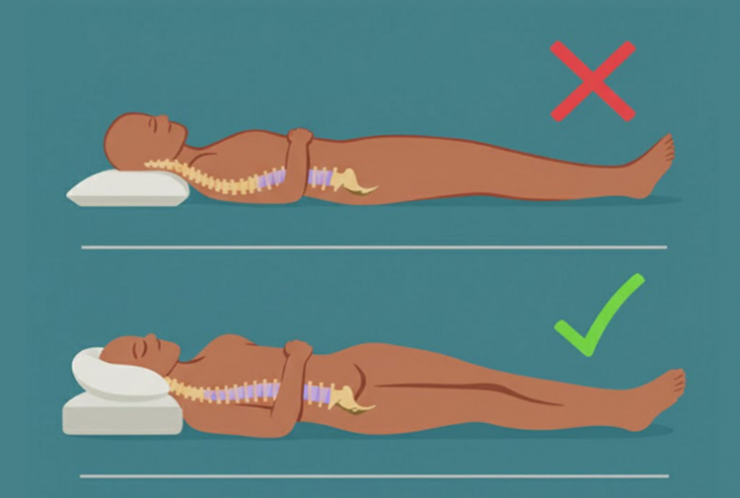A good night’s sleep is not just about how long you rest, but how you position your body while sleeping.
Many people wake up with back pain, stiff necks, or even numbness in their arms and legs — not realizing that their sleeping posture is often the real culprit.
The image above shows exactly what you should and shouldn’t do when it comes to sleeping positions.
Let’s break it down and explain why some positions hurt your back and which ones actually help you heal while you sleep.
1.Lying Flat on Your Back (Wrong Way)
When you lie flat on your back with your legs straight, your lower spine (lumbar area) naturally curves away from the mattress.
This creates pressure in the lower back, leading to pain, stiffness, and discomfort in the morning.
Over time, this posture can flatten your spine’s natural curve, contributing to chronic back pain or even disc problems.
2.Lying on Your Back with Support (Correct Way)
If you love sleeping on your back, here’s the right way to do it:
Place a small pillow or rolled towel under your knees.
This slight elevation helps maintain your spine’s natural curve, relieving pressure from the lower back.
You can also use a thin pillow under your head, keeping your neck in line with your spine — not tilted forward or backward.
Bonus tip: A memory foam pillow under the knees offers perfect support and comfort.
3.Sleeping on Your Side Without Support (Wrong Way)
Many people sleep on their side, but few do it correctly.
If your upper leg rests directly on the mattress, your spine twists slightly, causing misalignment in your hips and lower back.
This can result in sciatic nerve irritation, morning stiffness, and even shoulder pain.
4.Sleeping on Your Side with a Pillow Between the Knees (Correct Way)
This is one of the best sleeping positions for spinal health.
Place a firm pillow between your knees — this keeps your hips, pelvis, and spine perfectly aligned.
It also reduces pressure on your lower back and helps the muscles relax.
Your head pillow should be thick enough to fill the space between your ear and shoulder, preventing neck strain.
Result: Less tension, better blood flow, and a more restorative night’s sleep.
Why Sleeping Position Matters
Your spine naturally has three gentle curves — one at the neck, one at the mid-back, and one at the lower back.
Sleeping in the wrong position disturbs this alignment, forcing muscles and ligaments to work overnight just to keep you balanced.
Over time, this can lead to:
Chronic neck and back pain
Headaches and migraines
Poor posture during the day
Fatigue and reduced sleep quality
How to Improve Your Sleep Posture
Use orthopedic pillows or memory foam cushions for better support.
Avoid sleeping on your stomach — it twists the neck and stresses the spine.
Stretch gently before bed to relax muscles.
Invest in a mattress that supports your natural curves (medium-firm is ideal).
Your bed should be a place of recovery, not strain.
By making small changes — like adding a pillow under your knees or between your legs — you can prevent back pain, improve sleep quality, and protect your spine for years to come.






Add comment